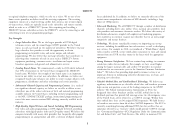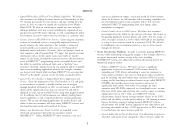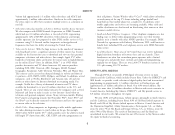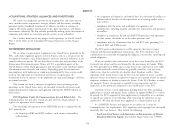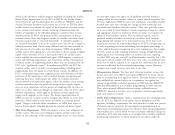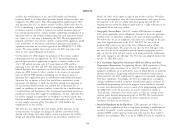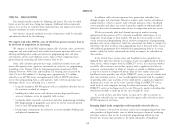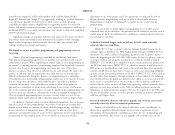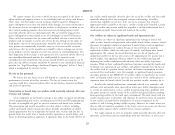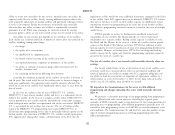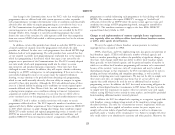DIRECTV 2010 Annual Report Download - page 35
Download and view the complete annual report
Please find page 35 of the 2010 DIRECTV annual report below. You can navigate through the pages in the report by either clicking on the pages listed below, or by using the keyword search tool below to find specific information within the annual report.DIRECTV
Communications Act, as well as limits on the commercialization of assurance that we will be able to obtain additional DBS capacity under
children’s programming applicable to cable operators. We believe that we are whatever system the FCC implements in the future.
in compliance with all of these requirements, but some of them require our In 2007, the FCC adopted new service and licensing rules for the BSS in
interpretations, which we believe are reasonable and consistent with industry the 17.3-17.8 GHz and 24.75-25.25 GHz bands, or 17⁄24 GHz BSS. This
practice. However, if we are challenged, the FCC may not agree with our spectrum, also known as the ‘‘reverse band’’ (in that transmissions from
interpretations. In addition, the FCC could, in the future, attempt to these satellites to consumers would occur in spectrum currently used for
impose additional public interest or content requirements on us, for uplinking programming to traditional DBS satellites), could provide a new
example, by seeking to impose rules on indecent programming. source of additional DTH capacity. DIRECTV currently holds
•Emergency Alert System. The Emergency Alert System, or EAS, requires authorizations for satellites in this band at three orbital locations. However,
participants to interrupt programming during nationally declared foreign operators who may have international priority have indicated an
emergencies and to pass through emergency related information. The FCC interest in using slots that may conflict with some or all of these licenses.
has adopted rules that require satellite carriers to participate in the One foreign licensed operator, Spectrum Five LLC, has filed a petition
‘‘national’’ portion of EAS. It is also considering whether to mandate that seeking reconsideration of one of DIRECTV’s licenses at an orbital location
satellite carriers also interrupt programming for local emergencies and where Spectrum Five also proposes to operate, and that petition remains
weather events. We believe that any such requirement would be very pending.
difficult to implement, would require costly changes to our DBS/DTH •Rules Governing Co-Existence With Other Satellite and Terrestrial
system, and, depending on how it is implemented, could inconvenience or Services and Service Providers in the MVPD Industry. The FCC has
confuse our viewers. The FCC is also considering whether to require that adopted rules to allow non-geostationary orbit fixed satellite services to
EAS alerts be provided in multiple languages or via text messages, which operate on a co-primary basis in the same frequency band as the one used
could also prove difficult and costly to implement depending upon the by direct broadcast satellite and Ku-Band-based fixed satellite services. In the
nature of any such requirement adopted. same proceeding, the FCC concluded that multi-channel video and data
•Spectrum Allocation and License Assignment Rules. We depend upon the distribution services, or MVDDS, can share spectrum with DBS operators
FCC’s allocation of sufficient DBS frequencies and assignment of DBS on a non-interference basis, and adopted rules and a method for assigning
licenses in order to operate our business. DBS frequencies and available licenses in that service, as well. While the FCC has established service and
DBS orbital locations capable of supporting our business have become technical rules to govern the non-geostationary orbit and MVDDS services
increasingly scarce. While we have obtained additional DTH service capacity to protect DBS operations from harmful interference, these rules may not
and continue to explore new sources of DBS/DTH capacity, there can be be sufficient to prevent such interference, and the introduction of such
no assurance that we will obtain further capacity. In addition, the FCC had services into spectrum used by us for DBS service may have a material
adopted a system of competitive bidding to assign licenses for additional adverse impact on our operations. In addition, one MVDDS operator
DBS frequencies. On June 21, 2005, the United States Court of Appeals for recently received a conditional waiver of the applicable rules so that it could
the D.C. Circuit held that such an auction process was not authorized by operate its system in Albuquerque, New Mexico at substantially higher
statute. The FCC subsequently voided the previous auction and power levels, which may have a material adverse impact on our operations
implemented a freeze on applications for authority to provide DBS service in that market. Although we have opposed that waiver request, there can be
in the United States using new frequencies or new orbital locations not no assurance that the FCC will deny it.
assigned to the United States in the ITU Region 2 Broadcasting Satellite On August 18, 2006, the FCC released a notice of proposed rulemaking
Service, or BSS, Plan. On August 18, 2006, the FCC began a proceeding to regarding the possible operation of ‘‘tweener’’ or ‘‘short spaced’’ satellites—
identify a new system for assigning DBS authorizations. There can be no
13


